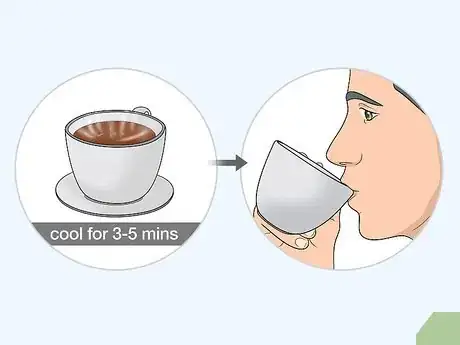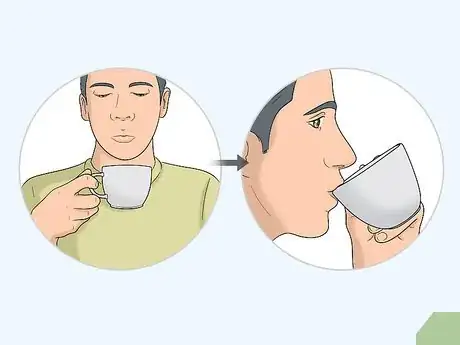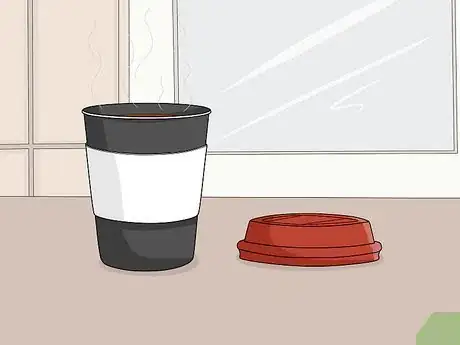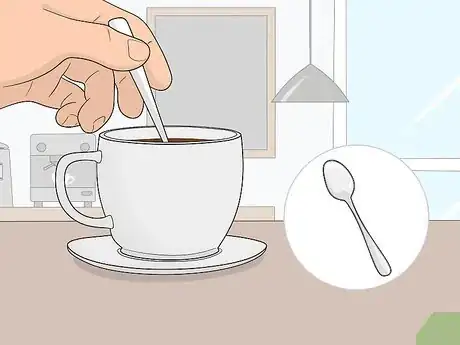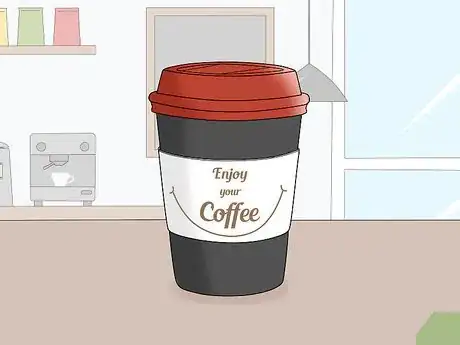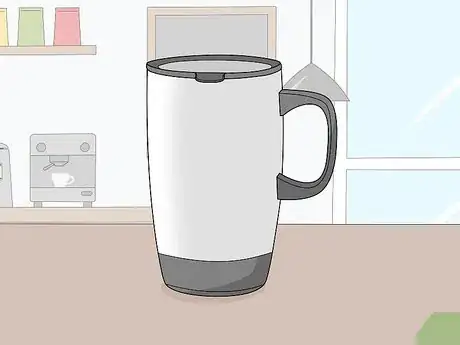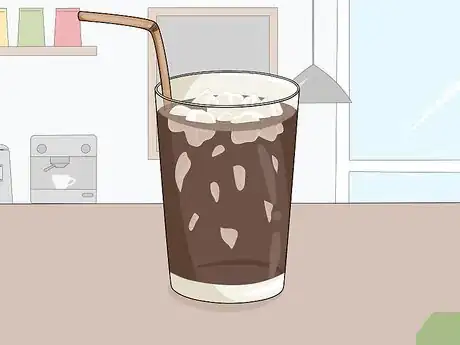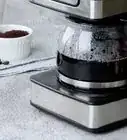This article was co-authored by wikiHow staff writer, Eric McClure. Eric McClure is an editing fellow at wikiHow where he has been editing, researching, and creating content since 2019. A former educator and poet, his work has appeared in Carcinogenic Poetry, Shot Glass Journal, Prairie Margins, and The Rusty Nail. His digital chapbook, The Internet, was also published in TL;DR Magazine. He was the winner of the Paul Carroll award for outstanding achievement in creative writing in 2014, and he was a featured reader at the Poetry Foundation’s Open Door Reading Series in 2015. Eric holds a BA in English from the University of Illinois at Chicago, and an MEd in secondary education from DePaul University.
This article has been viewed 22,618 times.
Learn more...
There’s nothing better than that first sip of coffee in the morning. Your eyes open up a little, you suddenly feel awake, and you’re ready to start your day right. But if you’re too excited to take that first sip or you’re still a little groggy when you go to pour your cup, you could end up with a nasty burn. The truth is, the fresh cup coming out of that commercial coffee maker is likely 160–180 °F (71–82 °C), which is more than hot enough to cause third-degree burns.[1] Luckily, there are plenty of ways to cool your coffee off and keep yourself safe while you’re pouring and drinking that delicious java.
Steps
Cooling the Coffee
-
1Add cold creamer or milk to reduce the temperature immediately. If you tend to drink your coffee black, try giving coffee creamer or milk a shot! Keep the creamer or milk in your fridge and add 1–3 teaspoons (4.9–14.8 mL) to your coffee based on your personal preference. Alternatively, add cream after ordering a cup at the local coffee shop. The cold milk or creamer will instantly lower the temperature of the coffee, which will minimize the odds that you burn yourself.
- Coffee creamer comes in a variety of flavors, so if you don’t like regular coffee creamer, you may have simply not found your preferred flavor. There are also non-dairy creamers that you can use if you’re lactose intolerant.
-
2Drop a single ice cube into your coffee if you don’t like creamers. If you prefer to drink your coffee black, drop a single ice cube to the hot coffee to cool it off. The ice cube will melt in 30-60 seconds, and the small dose of cold water will lower the overall temperature of your coffee. Keep in mind, this will water your coffee down a little, although if won’t dramatically alter the flavor.Advertisement
-
3Give freshly brewed coffee 3-5 minutes to cool before taking a sip. In terms of flavor and safety, the optimal temperature for a hot beverage is 136 °F (58 °C). However, most coffee makers heat the coffee to 160–180 °F (71–82 °C). When you pour yourself a cup of coffee at home, let it sit out on the counter for 3-5 minutes to let the temperature drop on its own.[2]
- If you really want to get scientific with it, buy a glass thermometer and put it in your coffee after letting it cool. This will let you know if you if you’ve reached the optimal temperature for a perfect cup of coffee.
Warning: Even at 136 °F (58 °C), the coffee is still very hot. If you spill coffee at this temperature, it may cause a burn after 10-15 seconds of skin contact. It should be fine to start slowly sipping it, though.
-
4Blow over the surface of the coffee for 8-10 seconds before taking each sip. A lot of people blow on their coffee to cool it off when they first get it, but few people remember to do it before taking every sip while the coffee is still hot. Blowing on the surface of the coffee is actually quite effective at cooling it, but it only reduces the temperature at the surface. While the coffee is still steaming, blow on it for 8-10 seconds before taking a drink. Blow on the surface for a few seconds after each additional sip.[3]
- If your coffee is scalding hot, blowing on it isn’t going to dramatically cut the temperature down on its own. You’re better off letting it cool on its own for 3-5 minutes before doing this.
- If you can’t tell how hot the coffee is, always blow on it before slowly taking a small sip.
-
5Remove the to-go cup's lid to cool the coffee faster. If you grab a drink at your local coffee shop, grab a seat and take the lid off. Removing the lid will dramatically decrease the temperature and let it cool. Wait 3-5 minutes for the coffee to stop steaming before putting the lid back on to head out or taking a sip from your beverage.[4]
- Do not do this if you’re driving or walking around. While it will still cool the coffee, you’re way more likely to spill and burn yourself with the lid off while you’re on the move.
-
6Stir your hot coffee with a metal spoon for 30-45 seconds to release some of the heat. Moving the coffee around in the cup will expose more of the liquid to the open air above it. The metal spoon will act as a conduit and absorb a lot of the heat in the heat in the coffee. Stir your drink with a metal spoon for 30-45 seconds to cool it off quickly.[5]
- Only do this if your cup or mug is resting on a table and it isn’t filled to the brim with coffee.
- The spoon has to be metal if you want to cool the coffee off dramatically.
Preventing Spills and Burns
-
1Use a cup sleeve to keep the mug or cup from burning you. If you’re at a coffee shop, ask for 2-3 of those cardboard sleeves that go over the cup. For your home coffee, pick up 2-3 fabric cup sleeves and slide them under your mug before pouring your coffee. This will keep you from burning your hands on the hot ceramic mug or paper cup.[6]
- There are lots of really cool cloth sleeves that you can buy online. They typically don’t cost more than a few dollars too!
-
2Pour your coffee in an insulated travel mug with a sturdy lid to drink on the go. If you’re taking your coffee on the road, use an insulated travel mug with a heat-proof lining. If your coffee is really hot, the insulated lining will keep your mug from getting really hot and burning your hands when you pick it up.[7]
- If your mug doesn’t have a sturdy lid, you risk spilling the coffee and burning yourself.
- A high-quality insulated thermos will also work if you’re a huge fan of coffee and drink a large amount over a longer period of time.
- Never bring an open ceramic mug filled with coffee into your car. You’re extremely likely to spill if you do this.
-
3Switch to iced coffee instead of hot coffee to avoid hot spills or burns. If you’ve never given iced coffee its fair shake, you should. From delicious mocha coffee with tons of creamer to cold brew black coffee, there are just as many options and flavors available when compared to the hot stuff. If you tend to burn yourself by spilling in the car or when you’re a little groggy in the morning, consider swapping your hot coffee out for an iced version of the drink.
Tip: You can also get your coffee much faster in the morning if you switch to iced coffee, since you can brew it and store it in fridge the night before.
-
4Walk slowly with coffee and don’t carry too much stuff. When you’re taking a mug of coffee to your desk, front porch, or couch, be careful and walk slowly. Walk smoothly to avoid spilling the cup and burning yourself. If you’re on the run or at work, avoid carrying other items in your hands while you’re transporting your coffee. It may sound obvious, but a lot of people forget they’re carrying an extremely hot cup of coffee when they’re on the go.[8]
- Alternatively, you can keep your coffee in a thermos with a strap and hang the strap over your shoulder when you’re on the move. Make sure that the lid is on tight before doing this, though.
Warnings
- If you’re driving with a cup of coffee, always leave it in a cup holder while you’re moving. A light fender bender can turn into a hospital visit if you spill hot coffee over yourself while you’re driving.⧼thumbs_response⧽
References
- ↑ https://www.ncbi.nlm.nih.gov/pubmed/18226454
- ↑ https://www.ncbi.nlm.nih.gov/pubmed/18226454
- ↑ https://www.wired.com/2016/11/physics-says-best-way-deal-hot-coffee/
- ↑ https://www.wired.com/2016/11/physics-says-best-way-deal-hot-coffee/
- ↑ https://www.esrl.noaa.gov/gmd/education/info_activities/pdfs/TBI_heat_transfer.pdf
- ↑ https://www.goodhousekeeping.com/travel-products/travel-coffee-mug-reviews/g785/best-travel-coffee-mugs/
- ↑ https://www.goodhousekeeping.com/travel-products/travel-coffee-mug-reviews/g785/best-travel-coffee-mugs/
- ↑ https://www.huladaddy.com/articles/coffee-burns.htm


